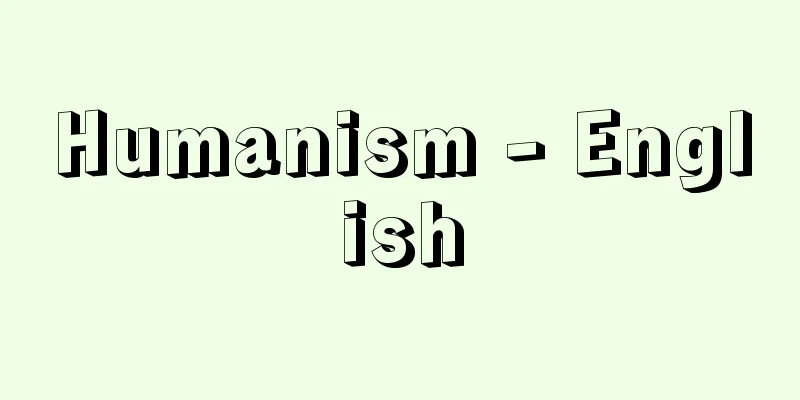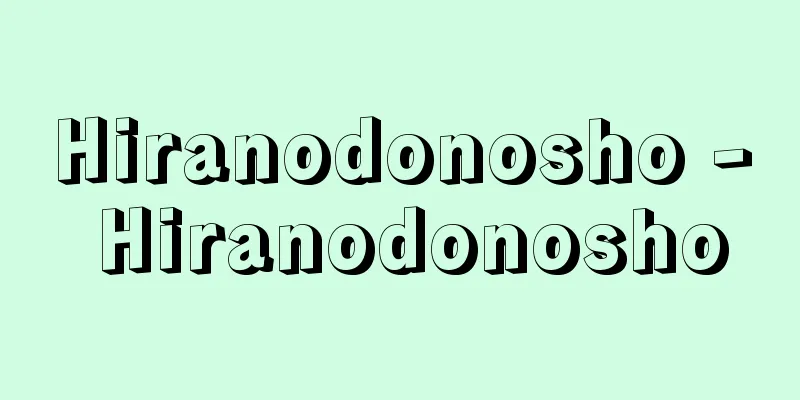Humanism - English

|
It is a word that refers to a very broad range of ideological tendencies, mental attitudes, and worldviews, and can be translated as humanism, humanism, humanitarianism, etc. The only common meaning among these is probably the respect for humanity and human nature. [Katsuhiko Ito] Respect for humanityIn the 15th and 16th centuries in Europe, a movement to revive ancient literature and arts arose, and in opposition to the theology-centered academic system that had existed since the Middle Ages, scholars of the new era shouted, "We need more humane arts and sciences!" In other words, the revival of ancient arts and sciences was intended to revive the natural humanity that was suffocating under the authority of the Church. The Greek and Roman classics were called humaniora (that which makes us more human), and a new educational philosophy was born that sought to enhance human nature through the study of these classics and realize the ideal image of a human being for the new era. The word humanism was born from this "more humane" (humanior, the comparative form of the Latin humanus, human). This is what is called Renaissance humanism. For example, Petrarch collected ancient manuscripts by Virgil and Horace from a young age, and by understanding the ancients he sought to derive an ideal image of humanity from them. As the Renaissance movement expanded, this spirit of humanism spread from Italy across the Alps to the whole of Europe, and a new ideal of humanity was established by Erasmus of the Netherlands and Montaigne of France. This was a philosophy that respected human beings as they are, their natural humanity, and sought to pursue the quest for wisdom from the standpoint of this humanity. [Katsuhiko Ito] Various Orientations of HumanismIn the 17th century, humanism was linked to the scientific spirit. Descartes sought truth from the "standpoint of man as far as he is human." Unlike theologians, he tried to understand the world not by the light of grace, but by the "natural light" inherent in man. He also sought to reach a solid foundation in learning through mathematical methods, and from there to complete a system of philosophy as wisdom useful for life. It was to be "a complete knowledge of all things known by man in relation to the guidance of life, the maintenance of health, and the invention of all techniques." In other words, the humanist idea of wisdom underwent a fundamental transformation by combining it with new science and technology. This task of unifying science and humanism was inherited by the Enlightenment thinkers of the 18th century. Humanism in this era pursued scientific rationality not only in nature, but also in the fields of society, politics, and economics, and thereby sought to expand humanity as much as possible. This awareness of the problem gave rise to the "idea of progress," which could be said to be the poster child of the 18th century Enlightenment. In the second half of the 18th century, a spiritual movement called "New Humanism" arose in Germany. This was a reaction against the abstract rationalism and mechanistic worldview of the German Enlightenment. It was pioneered by Winckelmann, who promoted the ideal of Greek beauty, and was continued by Lessing, Herder, Goethe, Schiller, and Humboldt, and was perfected in the poetry of Hölderlin. One of these men, Herder, revived the classical ideal of Humanität, making it the ideal that all humans should possess as long as they are human, and this formed the basis of the humanistic education taught at the Gymnasium (high school) in Weimar. At the beginning of the 20th century, something called "Third Humanism" appeared in Germany, which was a neo-humanist movement born out of a new awareness of issues among classical scholars. The British philosopher Schiller also called his pragmatist worldview humanism. According to him, truth is not eternal, but is created by human behavioral experiences and is determined by practical usefulness. He argued that God or an absolute spirit is unnecessary as an explanatory principle for the world, and that humans themselves must be established as the principle that actively remakes the world. As is clear from the above examples, humanism has appeared in a wide variety of ideological forms in each era. The only common aspect among these is the respect for "humanity." However, this "humanity" is often pursued in opposite directions. Some argue that humans can only truly realize their humanity in a relationship with something infinitely beyond humanity, that is, with God or the Absolute. Others, on the contrary, argue that true humanity is to develop the natural qualities of humans as long as they are human. Still others argue that the thorough pursuit of rationality in science and technology will ultimately lead to the expansion of humanity and the realization of human happiness. In response, others argue that the development of science and technology has dragged humans to a position equivalent to that of a slave, rather than the protagonist of mechanical civilization, and that the rationalization and mechanization of the world are a process of dehumanizing humans, and that humanism can only be realized by resisting this. In this way, modern humanism is splitting into opposite directions. Similarly, even if we talk about respecting "humanity," the question is in what direction we should expand that humanity. [Katsuhiko Ito] Beyond HumanismIt is said that Cicero was the first to use the word "humanitas," but his humanitas did not necessarily represent the entire ideal of humanity; it merely meant the elegance that only civilized people possess. The Romans would say "homo humanus," which was originally a phrase used to describe "homo barbarus," a foreigner. In other words, the Romans were barbarians with low levels of culture and education, and in comparison, the Romans were culturally refined people who had the culture inherited from Greece and the various virtues of the Romans. In 1537, Pope Paul III issued an encyclical recognizing Indians, blacks, and native Americans as "real human beings," which means that they had not been recognized as human until then. If humanism is a way of thinking that considers only those who have the same customs, habits, and ideas as oneself to be human, and that all other people are beings that deviate from the standard of humanity, then this must be said to be a very self-centered way of thinking. If humanism emphasizes "humanness," it inevitably falls into this kind of egocentrism and patriotism, but since it is clear that egocentrism is not the essence of humanism, humanism is about constantly overcoming oneself to realize oneself. In other words, "going beyond humanism" is actually the essence of humanism. [Katsuhiko Ito] "My Humanism" by Kazuo Watanabe (Kodansha Gendai Shinsho)" ▽ "Modern Times and Humanism" by Tomio Nishikawa (1966, Horitsu Bunkasha)" ▽ "The Idea of Love" by Katsuhiko Ito (1967, Bancho Shobo)" ▽ "The Emergence of Dialogue and Ideas - Beyond Humanism" edited by Katsuhiko Ito (1967, Bancho Shobo) [References] | | | | | | | | | | | | | |Source: Shogakukan Encyclopedia Nipponica About Encyclopedia Nipponica Information | Legend |
|
非常に広い範囲の思想傾向、精神態度、世界観をさしていうことばで、人間主義・人文主義・人本主義・人道主義などと訳される。これらに共通の意味はといえば、人間性の尊重、人間らしさの尊重ということしかないだろう。 [伊藤勝彦] 人間らしさの尊重15、6世紀のヨーロッパに古代の文芸を復興しようとする運動がおき、中世以来の神学中心の学問体系に対抗して、新しい時代の学者たちの間から、「もっと人間らしい学芸を!」という叫びがおこった。つまり、古代の学芸復興によって、教会的権威のもとで窒息しかかっていた自然な人間性をよみがえらせようとしたのである。ギリシア・ローマの古典がフマニオーラhumaniora(もっと人間らしくするもの)ということばでよばれ、これの研究によって人間らしさを高め、新時代の理想的人間像を実現しようとする新しい教育理念が生まれた。 この「もっと人間らしい」(フマニオール――人間的humanusというラテン語の比較級humanior)からヒューマニズムということばが生まれたのである。ルネサンスの人文主義とよばれるのはこれである。たとえば、ペトラルカは若いころからウェルギリウスやホラティウスらの古写本を収集し、古代人を理解することによって人間の理想像をそこから引き出そうとした。こうした人文主義の精神は、ルネサンスの運動が拡大するとともにイタリアからアルプスを越えてヨーロッパ全土に波及してゆき、オランダのエラスムスやフランスのモンテーニュによって新しい人間性の理想が確立される。それは、あるがままの人間、自然な人間性を尊重し、この人間性の立場に立脚して知恵の探求を進めていこうとするものであった。 [伊藤勝彦] ヒューマニズムの諸方向17世紀になると、ヒューマニズムは科学的精神と結び付けられる。デカルトは「人間である限りの人間の立場」にたって真理を探求した。神学者のように、恩寵(おんちょう)の光によってではなく、人間に生具の「自然的光」によって世界を認識しようと努める。また、数学的方法によって学問の確実な基礎に到達し、そこから出発して人生に有用な知恵としての哲学の体系を完成しようとする。それは、「生活の指導、健康の保持、すべての技術の発明に関し人間の知りうるあらゆる事物についての完全な認識」となるべきものであった。つまり、ヒューマニストの知恵の理念が新しい科学や技術と結び付くことによって、根本的な変質を受けたのである。この、科学とヒューマニズムの統一という課題は、18世紀の啓蒙(けいもう)思想家たちによって受け継がれる。この時代のヒューマニズムは、科学的合理性を自然についてばかりでなく、社会、政治、経済などの分野にわたって追求し、それによって人間性を限りなく拡充していこうとするものであった。こした課題意識が、18世紀啓蒙思想の申し子ともいうべき「進歩の観念」を生み出したのである。 18世紀の後半には、ドイツに「新ヒューマニズムNeuhumanismus」の名でよばれる精神運動がおこった。これは、ドイツ啓蒙思想の抽象的な合理主義と機械論的世界観に対する反抗として生まれたもので、ギリシア的な美の理想を鼓吹したウィンケルマンを先駆者とし、レッシング、ヘルダー、ゲーテ、シラー、フンボルトらによって受け継がれ、ヘルダーリンの詩において完成される新しい人文主義運動であった。その1人ヘルダーは古典的な人間性Humanitätの理想を復活させ、これをすべての人間が人間である限り備えておくべき理想像とし、これによってワイマールのギムナジウム(高等学校)で行われる人文主義教育を基礎づけた。 20世紀の初め、ドイツに「第三人文主義」なるものが登場するが、これは古典研究者の間の新しい問題意識が生み出した新人文主義運動であった。また、イギリスの哲学者シラーは、自己のプラグマティズムの世界観をヒューマニズム(人本主義)の名でよんでいる。彼によれば、真理は永遠のものではなく、人間の行動経験によって生み出されるもので、実際的有用性によって規定される。世界の説明原理としては、神や絶対精神は不要であり、人間それ自身が世界を行動的につくりかえていく原理としてたてられなければならない、というのである。 以上の諸例からすでに明らかなように、ヒューマニズムはそれぞれの時代に、実にさまざまな思想形態において登場する。それらにおいて共通する面といえば、せいぜい「人間らしさ」の尊重ということにすぎない。ところが、その「人間らしさ」がしばしば正反対の方向において追求されるのである。ある者は、人間は人間を限りなく超えたもの、すなわち神や絶対者とのかかわりにおいてだけ自己の人間性を真に実現していくことができると主張する。他の者は、これとは反対に、人間である限り人間の自然的素質を伸ばしていくことが本当の人間らしさだという。またある者は、科学や技術の合理性を徹底的に追求していくことが結局は人間性を拡充し、人類の幸福を実現していくことにつながるという。これに対して、他の者は、科学技術の発達は人間を機械文明の主人公どころか、その奴隷に等しい位置に引きずり下ろしてしまった、世界の合理化、機械化は人間を非人間化していく過程であり、それに抵抗する方向においてのみヒューマニズムは実現されうるのだ、と反論する。このように、現代のヒューマニズムが向かうところは、正反対の方向に分裂しつつある。同じく「人間らしさ」の尊重をいうにしても、その人間性をいかなる方向に拡充していくかが問題なのである。 [伊藤勝彦] ヒューマニズムを超えて「人間らしさhumanitas」ということばを最初に使ったのはキケロであるといわれるが、彼のフマニタスというのはかならずしも人間性の理想全体を表さず、それは文明人だけがもつ優雅さといった程度の意味のことばであった。ローマ人は「人間らしい人間homo humanus」ということをいうが、これはもともと「異邦人homo barbarus」に対していわれたことばである。つまり、異邦人は文化的教養の低い野蛮な人間であるが、これに比べ自分たちはギリシアから受け継いだ教養に加え、ローマ人としての諸徳を備えた、文化的に洗練された人間なのだという自負が、このことばには込められているのである。 1537年にローマ教皇パウルス3世は、インド人や黒人やアメリカの土着民たちを「本当の人間」と認めることにする回勅を出したというが、そうすると、それまでは彼らは人間と認められていなかったことになる。ヒューマニズムというのが、自分と風俗、習慣、思想を同じくする人間だけを人間らしい人間と考え、それ以外の人間をすべて人間の規格から外れた存在と考える見方であるとすれば、これはずいぶん身がってなものの見方であるといわねばならない。ヒューマニズムが「人間らしさ」の強調であるとすれば、どうしてもこうした自己中心主義、自国中心主義に陥ってしまうが、自己中心主義にヒューマニズムの本質がないことは明らかであるから、ヒューマニズムは絶えず自己を乗り越えていくことによって自己を実現していくもの、ということになる。つまり、「ヒューマニズムを超えて」ということが、実はヒューマニズムの本質なのである。 [伊藤勝彦] 『渡辺一夫著『私のヒューマニズム』(講談社現代新書)』▽『西川富雄著『現代とヒューマニズム』(1966・法律文化社)』▽『伊藤勝彦著『愛の思想』(1967・番町書房)』▽『伊藤勝彦編『対話・思想の発生――ヒューマニズムを越えて』(1967・番町書房)』 [参照項目] | | | | | | | | | | | | | |出典 小学館 日本大百科全書(ニッポニカ)日本大百科全書(ニッポニカ)について 情報 | 凡例 |
Recommend
Stilwell, Joseph Warren
Born: March 19, 1883, Florida [Died] October 12, 1...
Lifespan - Jumyo
This refers to the duration of an organism's ...
James Bond
British author I. Fleming's novels, from Casin...
Human interest stories - Ninjobanashi
Also written as ninjyobanashi (human interest sto...
Foolish Wives
American film. Produced in 1922. This was the thir...
Hermann I
...The next prince, Louis the Pious, accompanied ...
domus religiosa (English spelling) domusreligiosa
...A place where Christian monks and nuns live to...
Ishimochi (Argyrosomus argentatus) - Ishimochi (English spelling)
A marine fish of the family Sciaenidae in the orde...
Avanti
…The term mahājanapada translates to “great count...
capsid
…Subunits are often aggregates of the same protei...
Efficiency movement
This refers to a movement to improve the work effi...
University of Pennsylvania
A private university in Philadelphia, Pennsylvania...
Takawarabi - Takawarabi
Also known as sheep fern. An evergreen perennial f...
Thrasyboulos
[raw]? [Died] 388 BC. Aspenzus, Greek general and ...
Value judgment - Kachihandan
A type of normative judgment in relation to factu...









